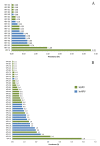Prevalence of Human Papillomavirus (HPV) Genotypes among Women During 2015-2020 in Mashhad, Iran
- PMID: 38301103
- PMCID: PMC10685731
- DOI: 10.34172/aim.2023.64
Prevalence of Human Papillomavirus (HPV) Genotypes among Women During 2015-2020 in Mashhad, Iran
Abstract
Background: Cervical cancer is the fourth most common cancer in women, and human papillomavirus (HPV) is the leading cause of cervical cancer. Cervical cancer screening and HPV vaccination are important in the incidence of cervical cancer.
Methods: This study was performed on Liquid Base Cytology (LBC) samples of 1214 women in Mashhad who were referred for cervical cancer screening in 2015-2020. Samples were examined by Single-Step PCR and Reverse Line Blot for HPV genotyping.
Results: 386 women (31.8%) were HPV PCR positive. HPV genotyping of 277 samples showed that HPV 31 (3%), 16 (2.5%), 51 (2.2%), 18 (2%), and 66 (1.8%) were the most prevalent high-risk HPV (hrHPV) genotypes. Among low-risk HPV (lrHPV) genotypes, HPV 6 (9.2%), 53 (4.7%), and 42 (2.8%) were the most common genotypes. The range of multiple infections varied between two to eight genotypes and the prevalence of multiple HPV infections (12.4%) was higher than single infections (10.4%). For women with single HPV infections, HPV 31 and 66 were equally the most common hrHPV genotypes, followed by HPV 16 and 39. In women with multiple HPV infections, HPV 31 was the most common hrHPV genotype, followed by HPV 51 and 16. For both the single and multiple HPV infections, HPV 6 was the most common lrHPV genotype, followed by HPV 53 and 42.
Conclusion: In conclusion, due to the high prevalence of HPV single and multiple infections, the need for governmentally supported HPV vaccination and through cervical cancer screening should be emphasized to prevent cervical cancer.
Keywords: Cervical cancer; Genotyping; Human papillomavirus; Iran; Liquid base cytology.
© 2023 The Author(s). This is an open-access article distributed under the terms of the Creative Commons Attribution License (https://creativecommons.org/licenses/by/4.0), which permits unrestricted use, distribution, and reproduction in any medium, provided the original work is properly cited.
Conflict of interest statement
The authors declare that they have no conflict of interest.
Similar articles
-
Prevalence of higher-grade dysplasia in persistently high-risk human papillomavirus positive, cytology negative women after introduction of the new cervical cancer screening in Germany.Cancer Causes Control. 2023 May;34(5):469-477. doi: 10.1007/s10552-023-01677-z. Epub 2023 Feb 28. Cancer Causes Control. 2023. PMID: 36854989 Free PMC article.
-
The clinical utility of extended high-risk HPV genotyping in risk-stratifying women with L-SIL cytology: A retrospective study of 8726 cases.Cancer Cytopathol. 2022 Jul;130(7):542-550. doi: 10.1002/cncy.22573. Epub 2022 Mar 21. Cancer Cytopathol. 2022. PMID: 35312217
-
Prevalence of human papillomavirus genotypes and precancerous cervical lesions in a screening population in the Republic of Korea, 2014-2016.J Gynecol Oncol. 2018 Jan;29(1):e14. doi: 10.3802/jgo.2018.29.e14. J Gynecol Oncol. 2018. PMID: 29185272 Free PMC article.
-
A meta-analysis of human papillomavirus prevalence and types among Iranian women with normal cervical cytology, premalignant lesions, and cervical cancer.J Med Virol. 2021 Aug;93(8):4647-4658. doi: 10.1002/jmv.26928. Epub 2021 Mar 26. J Med Virol. 2021. PMID: 33694179 Review.
-
The epidemiology of cervical cancer among indigenous women living in Latin America: A systematic review.Prev Med Rep. 2024 Dec 24;49:102955. doi: 10.1016/j.pmedr.2024.102955. eCollection 2025 Jan. Prev Med Rep. 2024. PMID: 39830367 Free PMC article. Review.
Cited by
-
Prevalence of Human Papillomavirus (HPV) Infection and its Association With Pap Smear Findings Among Women Attending a Gynecology Clinic in Khorasan Razavi-Iran.J Res Health Sci. 2024 Sep 30;24(4):e00629. doi: 10.34172/jrhs.2024.164. Epub 2024 Sep 30. J Res Health Sci. 2024. PMID: 39431654 Free PMC article.
-
Prevalence of HPV Genotypes among Greek Women in Association with Their Potential to Cause Precancerous Lesions.Microorganisms. 2024 Jul 11;12(7):1404. doi: 10.3390/microorganisms12071404. Microorganisms. 2024. PMID: 39065172 Free PMC article.
-
Distribution of HPV genotypes in Mashhad, Iran: insights from a 2022-2023 study.Virol J. 2024 Oct 7;21(1):248. doi: 10.1186/s12985-024-02518-4. Virol J. 2024. PMID: 39375749 Free PMC article.
-
Uncommon high distribution of HPV-16, HPV-54, and HPV-56 in female referred to a laboratory in Karaj, Iran: indications of a paradigm shift in HPV genotypes?Virol J. 2024 Aug 9;21(1):182. doi: 10.1186/s12985-024-02457-0. Virol J. 2024. PMID: 39123176 Free PMC article.
References
-
- Global HPV Vaccine Introduction Overview: Projected and Current National Introductions, Demonstration/Pilot Projects, Gender-Neutral Vaccination Programs, and Global HPV Vaccine Introduction Maps (2006-2023). 2022. Available from: https://www.path.org/resources/global-HPV-vaccine-introduction-overview/. Accessed March 2022.


